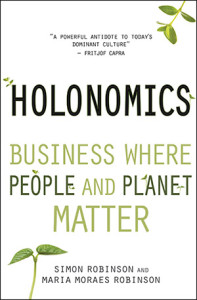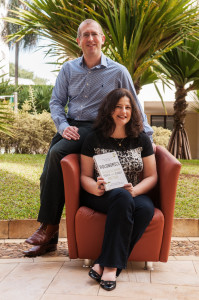New Year, New You: What is Holonomic Thinking and Why Should You Care?
by Floris Books • 26 January 2015 • Alternative Business and Economics • 0 Comments
All through January, here on the Floris Blog we will be celebrating the new. New ways of thinking, new ways of interacting with the world around us, and new ways of living and working meaningfully. New year, new you!
Today we’ll be sharing the secrets of holonomic thinking with you, courtesy of an excellent review of Holonomics by Simon Robinson and Maria Moraes Robinson first published on www.sustainablebrands.com.
 It is no secret that the private sector, for the most part, is failing to tackle today’s evolving social and environmental challenges, caused in large part by the nature of current standard business processes. It is getting more and more overwhelming for people to relate to businesses and their old-school practices. The main reason, some would argue, is that we fail to radically think and step out of the proverbial box we have been taught to exist in for generations. We seem to be collectively lacking either an agreed-upon vision of what to look for outside of that box, or the courage to pursue it, or both.
It is no secret that the private sector, for the most part, is failing to tackle today’s evolving social and environmental challenges, caused in large part by the nature of current standard business processes. It is getting more and more overwhelming for people to relate to businesses and their old-school practices. The main reason, some would argue, is that we fail to radically think and step out of the proverbial box we have been taught to exist in for generations. We seem to be collectively lacking either an agreed-upon vision of what to look for outside of that box, or the courage to pursue it, or both.
In a fascinating new book, Holonomics: Business Where People and Planet Matter, authors Simon Robinson and Maria Moraes Robinson reveal what it means to ‘think holonomically’ rather than mechanically. The book aims to not simply present this elegant mode of systems thinking, but also to give examples that make readers aware of a set of ideas not commonly discussed in this particular combination.
Holonomics brings biomimicry, life cycle analysis, systems thinking, spirituality, nature’s interconnectedness, philosophy, literacy, physics, biology and business all together in a way that opens readers’ eyes to uncommon dimensions of thought that could still have very practical applications. The content is arranged in three easy-to-follow parts that build on one another: The Dynamics of Seeing, The Dynamics of Nature, and The Dynamics of Business.
In Part One, the authors concentrate on attempting to point out how mechanistic thinking in science can limit the mode of thinking and knowing in all other fields of human endeavor, a limitation rooted in the ‘ways of seeing’ that are currently dominant in most societies. In this context, a mechanistic way of thinking can be described as “thinking the world as functioning like clockwork, engines and computers.” The first challenge to our way of thinking, then, is to change it from mechanistic thinking to systems thinking. However, the authors go on to argue that systems thinking, the latest and best yet model according to many, is still insufficient. Even though systems thinking has given us the blessing of seeing the structures that underlie complex situations, instead of just focusing on individual parts of the problem, the assertion here is that the evolution is complete when we go from mechanistic thinking (objects), to systems thinking (objects + relationships), to holonomic thinking (objects + relationships + meaning).
In Part Two, the authors give a variety of examples from natural systems and emphasize the importance of seeing an organization as a whole. One of the studies included in this part examines social insects, such as ants and termites, to illustrate a situation in which one can be faced with unexpected paradoxes. Ants and termites have tiny brains and therefore at the individual level their behavior can be seen as extremely disorganized, or even chaotic; it is hard to describe them as intelligent in any way, based on that. But when they are studied collectively, as a whole, their behavior is seen in a very different light, to the extent that we are still at a lost to be able to explain their extraordinary achievements. With this example we come to understand the importance of looking at the whole complex system. One has to study the whole, and, in doing so, be prepared to discover surprises as unexpected behaviors emerge.
Holonomic thinking encourages the understanding of relationships in their wholeness. This perception of ‘wholeness’ comes from both scientific and artistic consciousness. When perceiving phenomena, the underlying organizing principles appear in the imagination, in a place of authentic ‘belonging together.’ The better we see the ‘belonging together,’ the better our mental models will be — there will be effective feedback loops and we will become more aware of our own thinking, and also aware of mental processes and experiences that are otherwise hidden from us. At the same time, we shouldn’t become so entranced that we confuse any advanced model with the deeper truths of reality, the totality of which cannot be modeled explicitly. Holonomic thinking emphasizes the ‘belonging’ and the meaning of the systems and their coexistence.
In thinking about any practical complexity from a holonomic perspective, we come to realize that we can no longer separate ourselves from the environment. The environment and our ecosystems do not behave in predictable and linear manners. This, in turn, suggests that we need to tread carefully and cautiously, because we are not able to predict the outcome of our actions.
An inspiring example of applying holonomic thinking to leadership appears in Part Three and is based on the words of from Sergio Chaia, former president of Nextel Brazil. He argues that the ideal organization does not exist because everything is being transformed and is always evolving, whether genetically or energetically. Everything pulsates in every moment and turn; and, as everything is changing, so also is the ideal. There is, therefore, no watertight concept of ‘ideal’ that is achieved and comes to a conclusion. Since the ideal has a mutant characteristic, the ideal organization must also have the feature of constant mutation.
In Simon Robinson’s own words, ultimately the book’s aim is “to help the reader to be able to see both the intrinsic as well as extrinsic dimensions of complex systems, a new understanding of systems which they can then put into practice in their workplaces. Once a person is able to see authentic wholes and the processes, dynamics and meaning of living systems, they reach a deeper understanding of the world, one in which economics is no longer seen as separate from ecology. It is a new world of holonomics — business where people and planet matter.”
Tamay Kiper, www.sustainablebrands.com
Join us on the Floris blog and over on Twitter @FlorisBooks #NewYearNewYou where during January we’ll be sharing insightful articles and blogs from our growing collection of books on alternative business.
More about Holonomics and its authors
 Simon Robinson is a consultant in innovation, strategy and complexity. He was one of the founders of Genie Internet, the world’s first mobile internet portal and is a member of Biomimicry for Creative Innovation (BCI). He has a Masters degree in Holistic Science from Schumacher College, UK.
Simon Robinson is a consultant in innovation, strategy and complexity. He was one of the founders of Genie Internet, the world’s first mobile internet portal and is a member of Biomimicry for Creative Innovation (BCI). He has a Masters degree in Holistic Science from Schumacher College, UK.
Maria Moraes Robinson is an economist and consultant in strategy, change management and the ‘Balanced Scorecard’ management tool. She is a teacher and lecturer, interested in the themes of the economics of happiness and human values in education, and is the co-author of Strategy Management: Experiences and Lessons of Brazilian Companies and The Strategic Activist.
Holonomics is available now in paperback and ebook from florisbooks.co.uk.